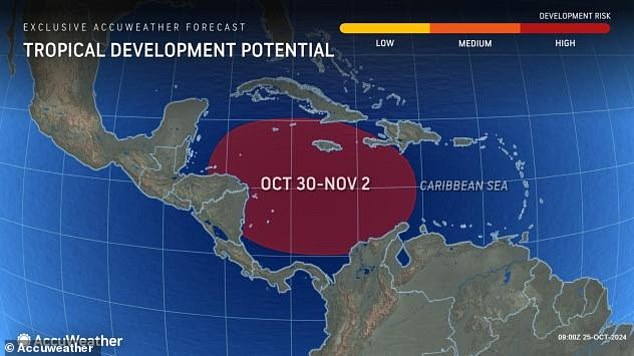Meteorologists are tracking an area of potential tropical storm development in a Caribbean that could send another hurricane barreling toward Florida.
Tropical storm Patty could form in the western and central region of the sea as early as next week, with a formation window of October 30 to November 2, according to AccuWeather.
As the Atlantic approaches the last month of hurricane season, the risk of tropical depression or storm development is currently ‘high’ in this area, which is near where tropical storm Nadine formed last week.
‘We suspect there will be another attempt for a tropical depression or tropical storm to brew in the western Caribbean during the middle to the latter part of next week,’ said AccuWeather Chief On-Air Meteorologist Bernie Rayno.
‘As a result, we have issued an advanced risk development zone.’
The exact path this storm could take remains unclear. But atmospheric conditions could prove favorable for a Florida path, said AccuWeather lead meteorologist Alex DaSilva.
If Patty does head toward Florida, it would make landfall on the state’s western coast, which is still recovering from back-to-back major hurricanes – Helene in September and Milton in October.

Meteorologists are tracking an area of potential tropical storm development in a Caribbean that could send another hurricane barreling toward Florida
The storm’s final path will be determined by the jet stream – the fast, narrow current of air that flows from west to east and encircles the globe.
‘As far as Florida goes, what would have to happen essentially is there would have to be some sort of dip in the jet stream to pull that storm to the north,’ DaSilva told Newsweek.
‘It is certainly possible that that happens. There have been storms during the month of November that have been pulled north towards the Florida peninsula.’
Depending on atmospheric conditions, it’s possible that potential Patty could move inland and impact the Carolinas, which are still reeling from the impact of Hurricane Helene.
The reason that meteorologists are paying close attention to this area is that its conditions are ripe for hurricane formation.
Water temperatures are warm over the Caribbean both at the surface and deep below, AccuWeather reported. This warmth can fuel tropical storms.
‘I know there will be showers and thunderstorms in this zone next week. The question is the wind shear,’ Rayno said.
Wind shear is a change in wind speed and/or direction over a short distance. It can make or break a tropical storm depending on several factors, including whether the wind shear is vertical or horizontal and how strong it is.

Water temperatures are warm over the Caribbean both at the surface and deep below, AccuWeather reported. This warmth can fuel tropical storms
As for how it could impact potential tropical storm Patty, ‘If there is low wind shear, which we expect, I think we will be getting a tropical depression or storm to form,’ Rayno said.
Additionally, this high risk of tropical storm formation is partly due to the Central American Gyre, a large, bloated area of low pressure that is more active at the start and end of the hurricane season.
When tropical storms form within this gyre, they can take longer to organize into a cyclone, resulting in days of stormy conditions and rough seas in the Caribbean before the storm is officially named, according to AccuWeather.
‘From a climatological standpoint, tropical storms that form in this area late in October and early in November tend to track into Central America or possibly to the north-northeast toward Cuba, Hispaniola and the Bahamas,’ AccuWeather Senior Meteorologist Alex Sosnowski said.
‘However, a track into Florida or the southeastern U.S. mainland is not out of the question at this early juncture,’ he added.
Despite the concern from meteorologists, the official National Hurricane Center (NHC) forecast shows no threat of tropical storm formation in the Atlantic Ocean over the next seven days.
If Patty does form, this storm would come on the heels of Hurricane Oscar, which made landfall in Cuba as a Category 1 storm, leaving at least six dead in its wake.
Tropical storm Nadine, which formed near the high-risk area meteorologists are currently tracking, made landfall in Belize before dissolving over Mexico and then reforming into Hurricane Kristy – all in just 72 hours.
This Category 5 storm is currently located roughly 650 miles southwest of Mexico’s Baja California peninsula and moving west at a steady 16 mph, but is not expected to make landfall.
This article was originally published by a www.dailymail.co.uk . Read the Original article here. .


